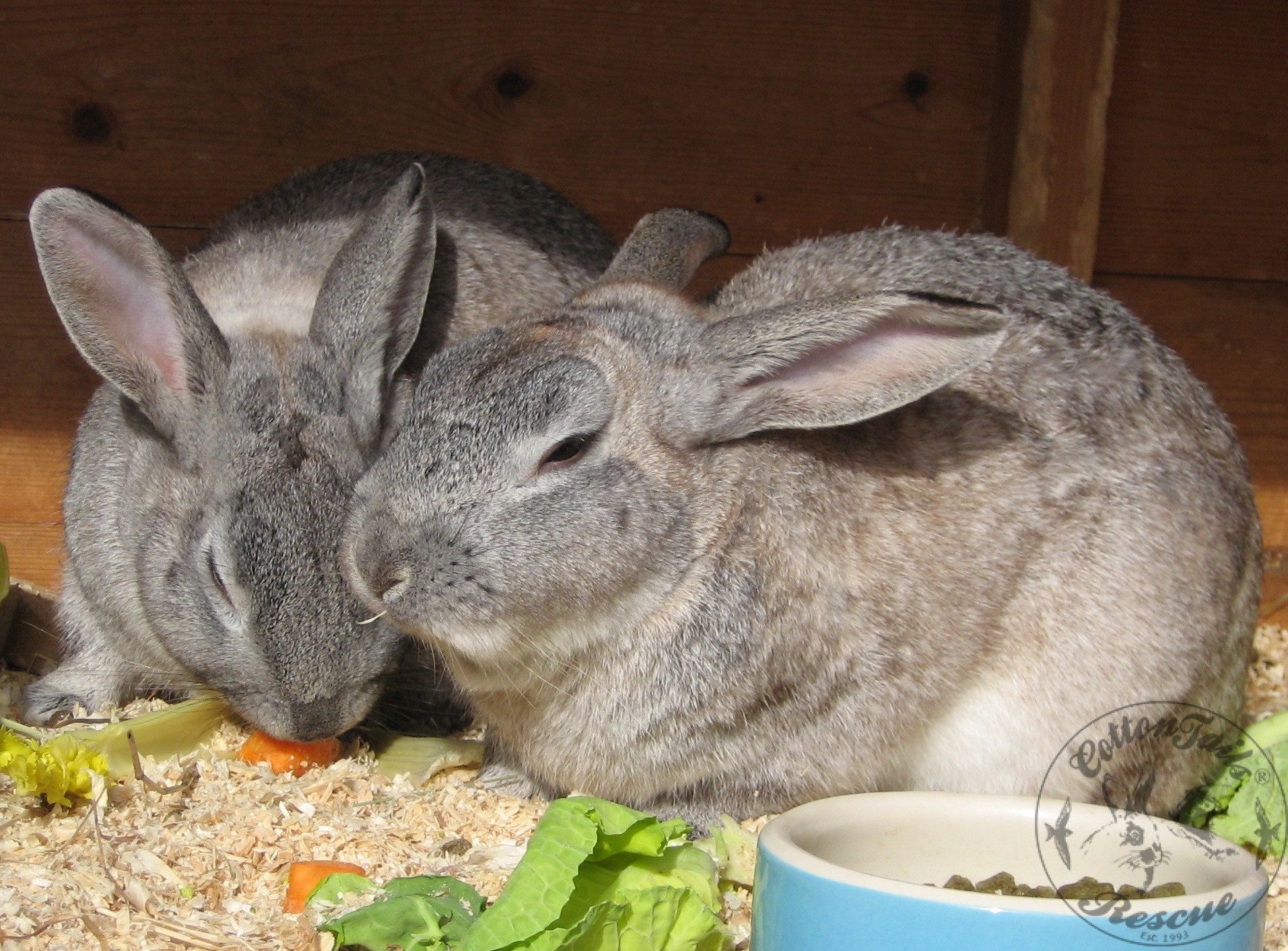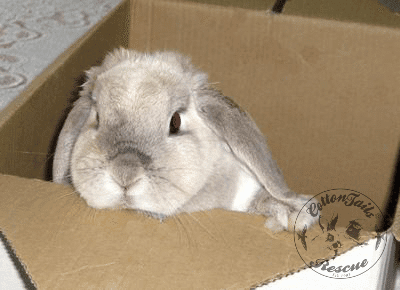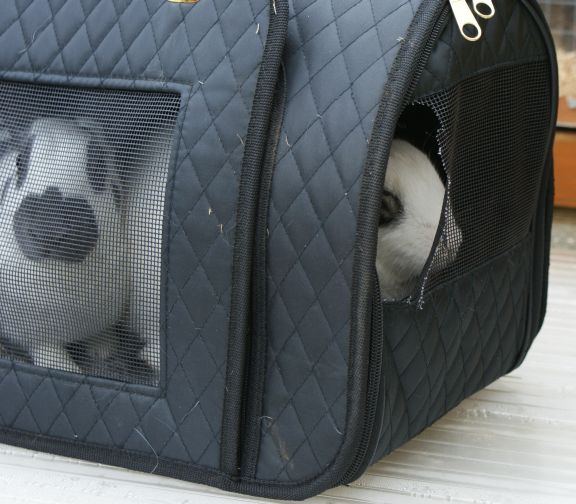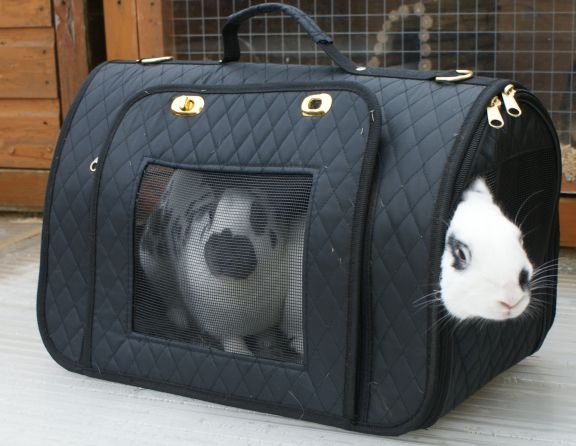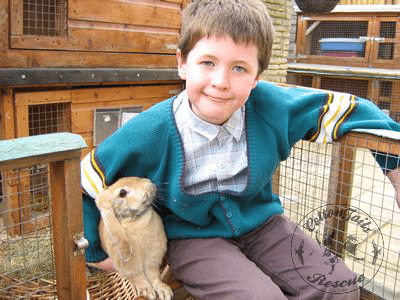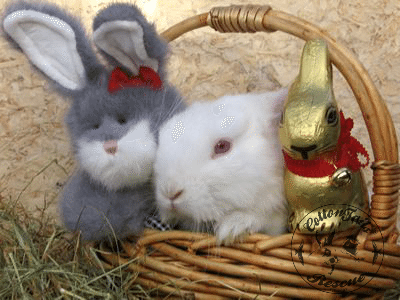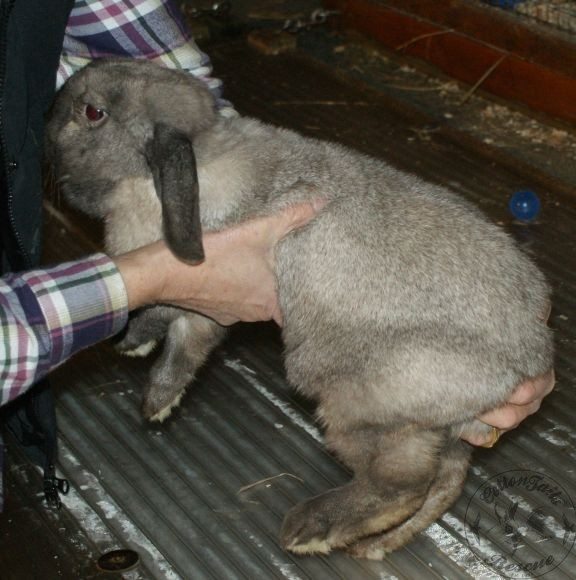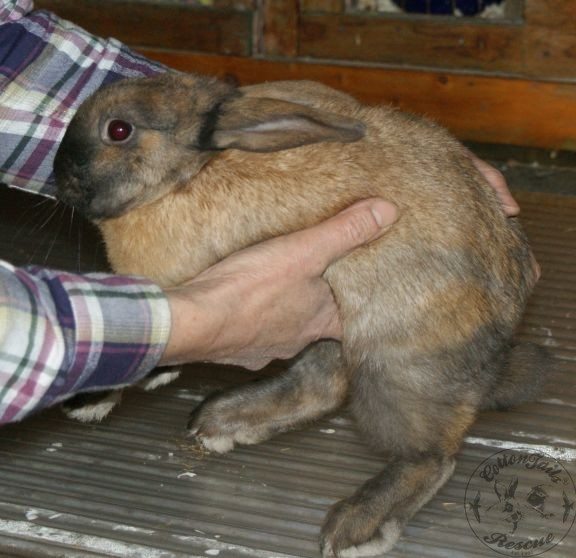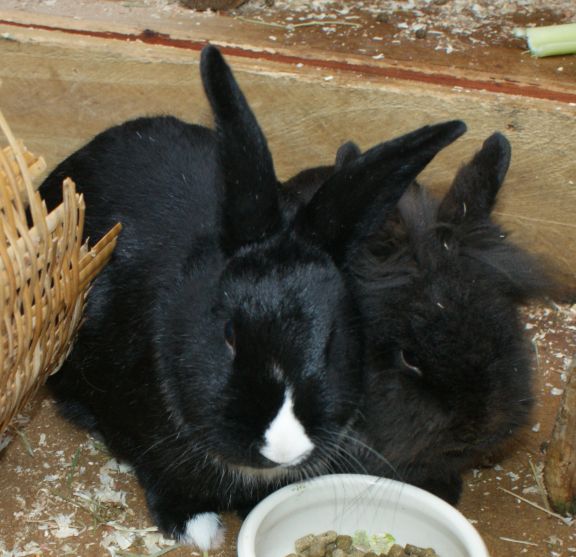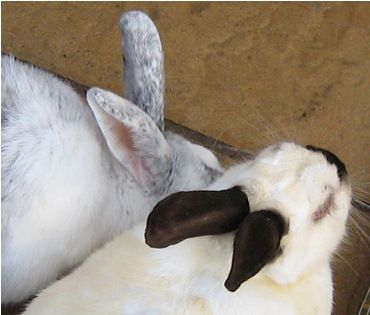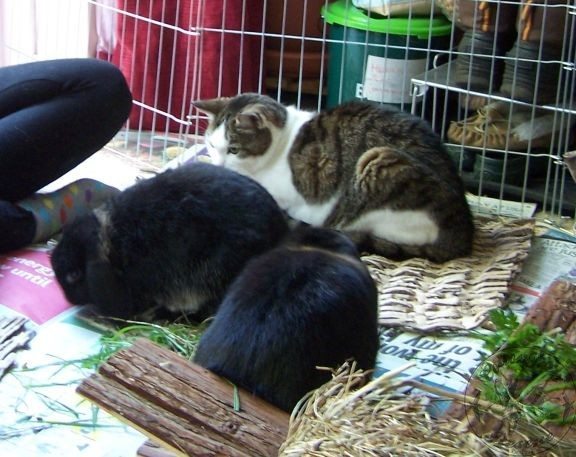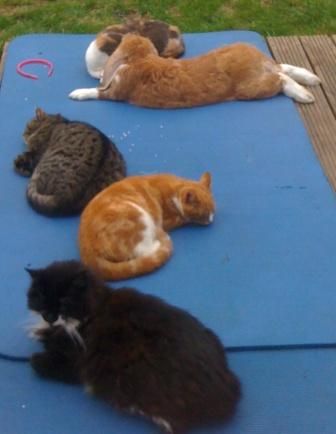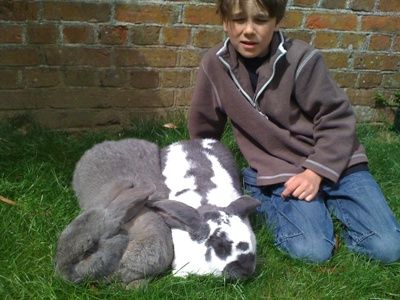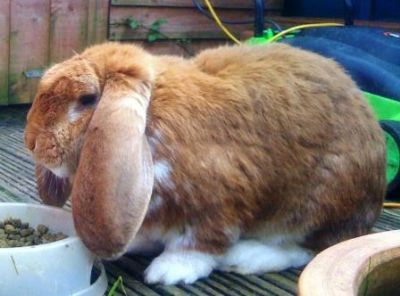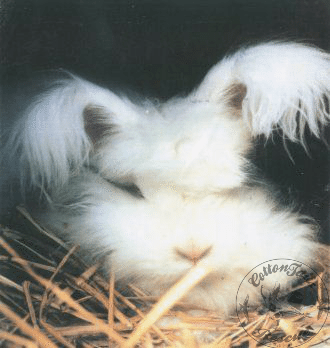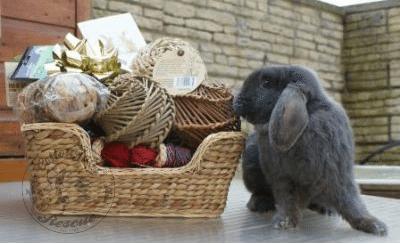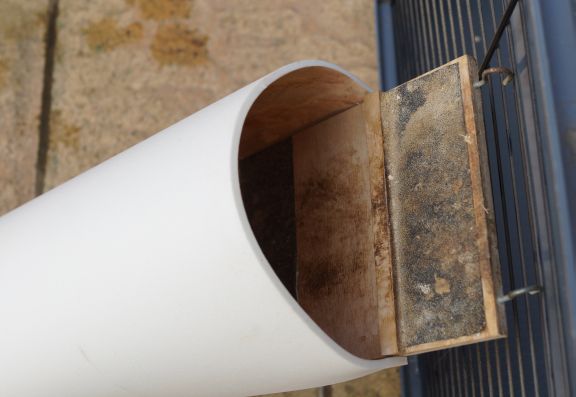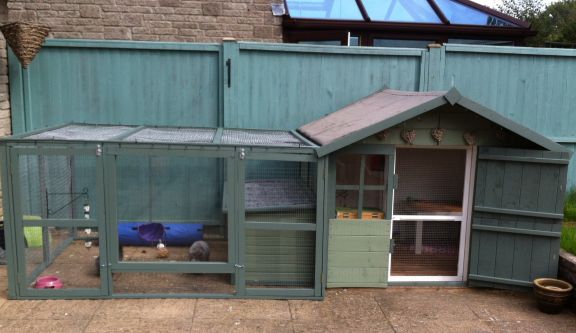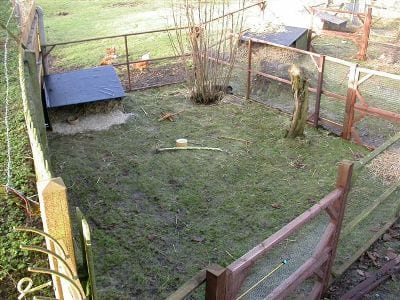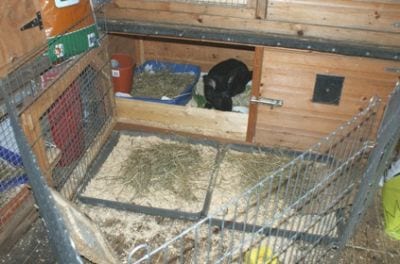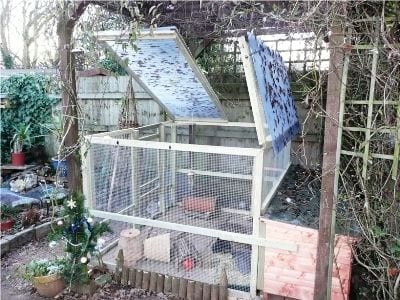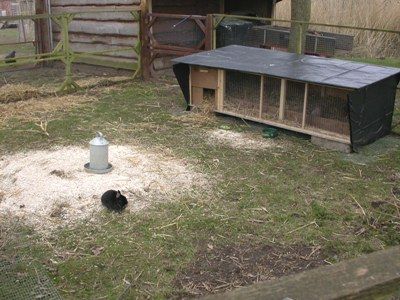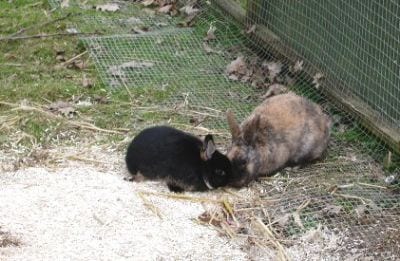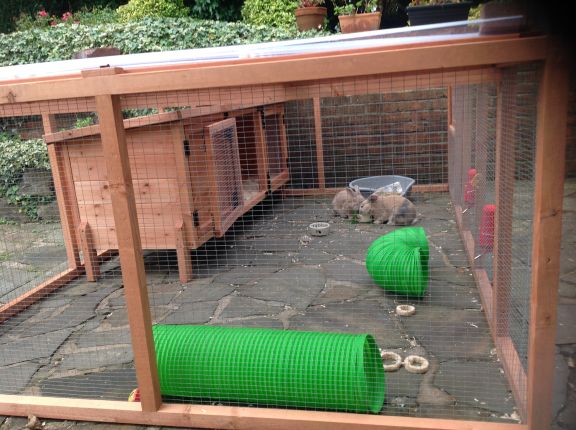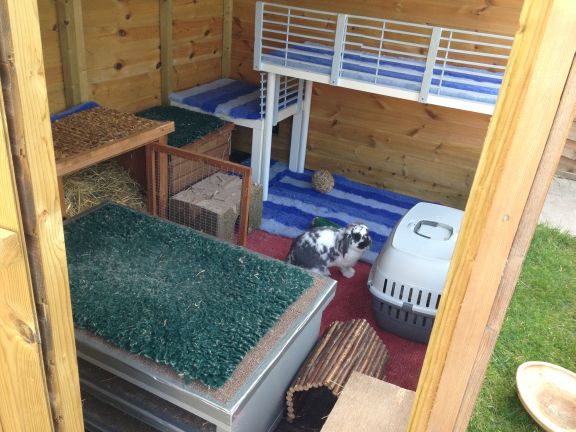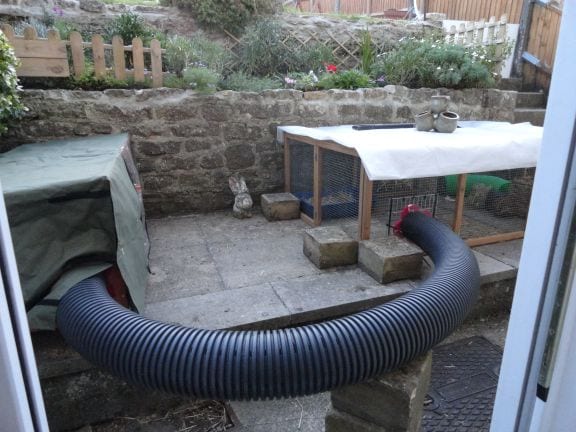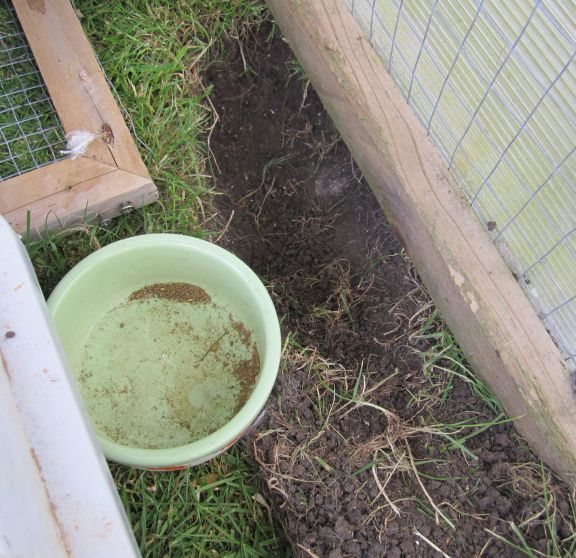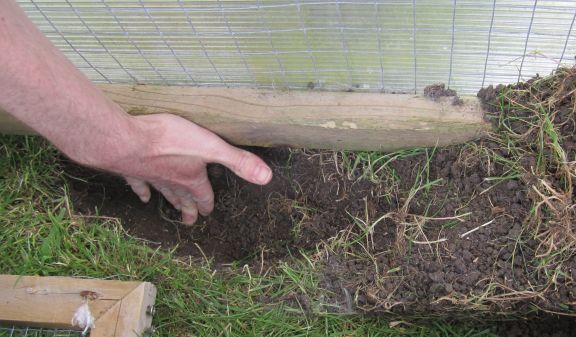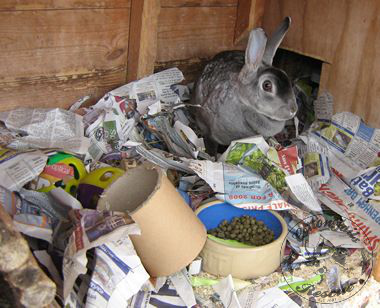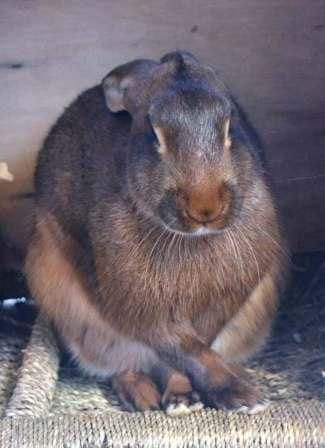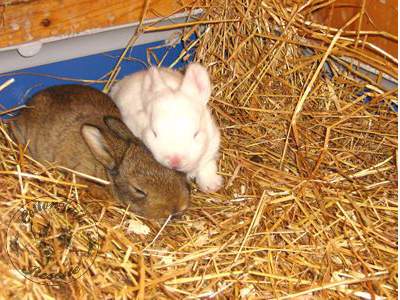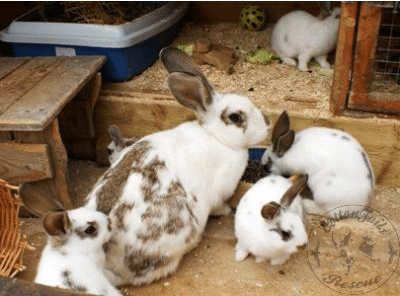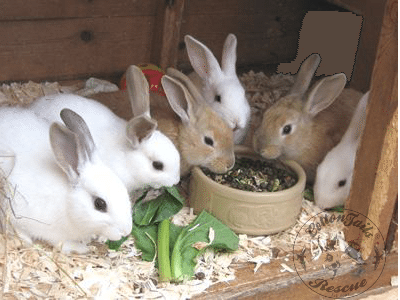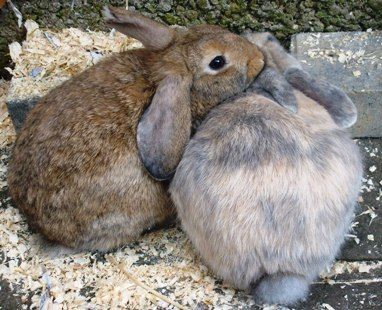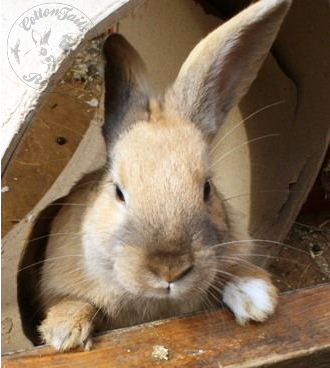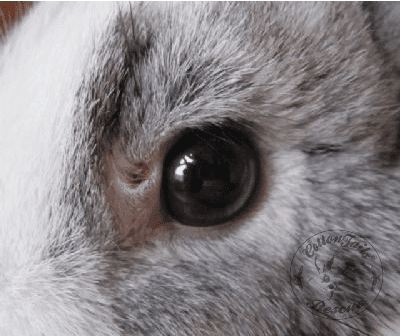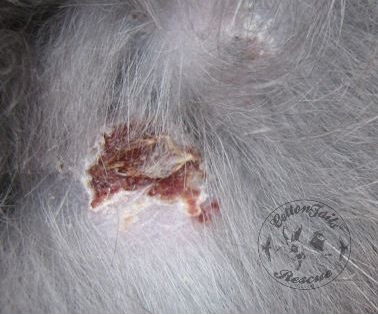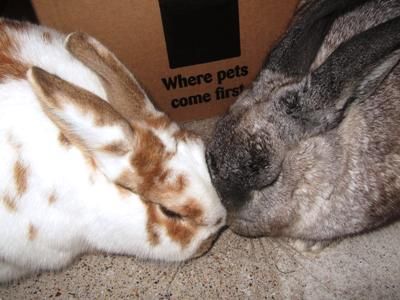What You Will Need
- Large hutch measuring at least 6′ x 2′ x 2′ but preferably bigger for a pair of rabbits, made of strong, good quality wood, with a run attached. A shed, Wendy House or aviary make good alternatives.
- Large run with a secure lid, permanently attached to the hutch or alternative accommodation, placed on paving slabs or with wire netting fixed securely underneath to stop them burrowing out and foxes digging in.
- Both hutch and run should have secure catches, such as heavy-duty bolts, to prevent foxes from scratching at the catches and forcing them open. See the section about housing and accommodation.
- Dust extracted wood shavings and good quality meadow hay. Soft straw is an additional option but not essential, whereas hay is vital to rabbit dietary health.
- Rabbit pellets or nuggets, such as Burgess Excel or Science Selective. Avoid muesli-type food as it encourages selective feeding. See separate section on diet and feeding further down the page.
- Green vegetables. See separate section on diet and feeding further down the page.
- A non-tip feeding bowl (usually 5” diameter by 2” high) and either a large 500ml-600ml water bottle or a large non-tip heavy bowl for water.
Basic Facts
- Life span – average 7-8 years. Small breeds can reach ten years or more, and very large breeds rarely reach 5 to 6 years.
- Sexual maturity can vary from 10 to 16 weeks. Gestation is 31 days. The average litter size is 6. Rabbits will have a litter every month unless prevented!
- Rabbits are fully grown by around six months old, although giant breeds can take up to 18 months to achieve full size.
- Rabbits are generally social animals; most will benefit from bonding with an opposite-sexed neutered friend. However, some rabbits are happier on their own, especially those that are particularly humanised – and many house rabbits come under that category. See the “Bonding” article on the website.
- Rabbits and guinea pigs should not be kept together.
- Rabbits always need a large hutch with a run attached permanently to exercise safely.
- Most rabbits do not make good pets for young children.
- Rabbits need to be vaccinated every year, which can be expensive.
- It can cost over £9000 per rabbit over its lifetime, not including unexpected vet bills (PDSA study 2013)
Common Problems, illnesses and conditions – you will find an extensive article here on the website.
Bringing Your Rabbit Home
It is best to be prepared and bring a secure pet carrier when you collect your rabbits. Plastic carriers are best; rabbits can eat their way out of cardboard if they are in there long enough! You are also best to avoid the fabric carriers, as although they look good and seem a good idea as they are easy to store, the photos below show what happens after a 30-minute journey in the car.
- Your carrier should be lined with a newspaper or towel, with a couple of large handfuls of good quality hay. However, check that the hay is clear of any knots or very long strands, as an active, anxious rabbit can end up getting a solid twist of hay stuck securely to its back foot to the extent that it can cut off the circulation or cut into the flesh – this may sound far fetched, but this happened to a rabbit that was brought in here to CottonTails. As a result, the rabbit had a cut on its foot, but luckily, the journey was less than an hour, so no further damage was done.
- Do not use wood shavings in the carrier as it can get into their eyes during a journey.
- If the journey is on a hot day or you will be travelling for more than an hour, you must bring a drinking bottle to offer water to the rabbit when the car is stationary. The bottle should NOT be left on the front of the carrier during the journey, as it will empty and soak the rabbit and bedding with the car’s movement.
- Make sure the carrier is positioned securely to prevent it from moving around and placed in the shade to avoid overheating.
- Once home, the rabbits should be placed in their new hutch/run with the bedding and food all ready for their arrival and left undisturbed for the rest of the day to allow them to settle in.
- It is vital that you find out what brand of food they are usually given as changing the diet suddenly can have fatal consequences (see separate article on “rabbit illnesses and common problems“).
- Find out if they have been using a water bottle or bowl. If they are used to a bowl, you must ensure they work out how to use a bottle to swap them over. Many rabbits used to a water bowl refuse to use a bottle and will dehydrate, even with a bottle straight in front of them – some cannot learn how to use a bottle.
Rabbits and Children
Rabbits make good family pets only if parents respect the rabbit’s needs and accept the children’s limitations. Rabbits should not be bought solely as a child’s pet as the adult will have to take responsibility for its care when the novelty has worn off (usually within a month). Rabbits are rarely cuddly and can bite and scratch if stressed or frightened. They do not usually like to be picked up, even if handled from a young age, and can easily injure their backs with fatal consequences if they fall or are dropped. Only two rabbits in the photo below are suitable to give to a young child at Easter (the time of year when the highest numbers of rabbits are sold) – and neither of them is the one in the middle!
The following was written by owner Sarah, who needed to find new homes for her rabbits:
“I have had animals, mainly cats, for the past 35 years and always considered myself a ‘responsible’ pet owner, buying the best food and treats and just generally spoiling my animals. Last year, however, I let my three children talk me into getting two baby rabbits. At the time, the boys were over the moon with the babies, but as the rabbits grew up and the boys discovered that the bunnies didn’t like being held and cuddled, they quickly lost interest, and the feeding and care were once again left to Mum to do. Although the rabbits were cute and lovely, I didn’t have the time to spend with them that I felt they needed and deserved.
This is where Mairwen at Cottontails stepped in and took them into her care. Having to do this made me feel very sad and upset that I had to put my pets in this situation. If I had thought about it and researched rabbits fully before we took them on, I might have realised that rabbits do not make ideal pets for children. I think children expect cute, cuddly bunnies that they can cuddle and love, but the reality is that even though they’re pets, they still have the ‘wild’ in them and do not like being handled. I would urge anyone to rethink getting one as a child’s pet. Consider the animal’s welfare first, no matter how much you want to please your child.”
 Handling
Handling
Contrary to popular belief, most adult rabbits do not enjoy being handled, although some will tolerate it better than others. This applies regardless of whether the rabbit is handled from a baby or not. Unfortunately, the true personality of a rabbit is not fully apparent until about 5-6 months of age. With this in mind, letting your new pet settle in with as little handling as possible is essential. Gradually build up his trust and confidence by talking quietly to him and gently stroking his head if he approaches you. When he has settled in, you can pick him up gently but firmly either by placing your hands around his middle or, if you are an experienced handler, by holding the loose skin behind his ears with one hand whilst supporting his hindquarters with the other (this is called scruffing and is not suitable for all rabbits and should not be tried by inexperienced handlers).
Aim to handle them infrequently, at least to start with, gradually building up the number of times a week if the rabbit tolerates it well. Remember that rabbits are naturally shy, quiet animals who hate being held above ground level. Gaining the trust of a rabbit takes time, patience and effort. See the section below for advice about checking your rabbit for fly strike. The two photos below illustrate how to pick up your rabbit, and the third photo shows a slightly different technique for a small rabbit.
Sexing
This is covered extensively in a separate article, “Sexing Your Rabbit“, and contains full descriptions and photographs to help you correctly identify the sex of your rabbit. Your rabbit must be sexed correctly, especially if they are to live with another rabbit. Sexing rabbits is not easy, and it is very common for people to make mistakes – even vets have been known to get it wrong!
Company
Keeping a rabbit on its own can result in a bored and depressed pet. However, not all rabbits are compatible, and some individuals refuse to bond, no matter how hard one tries. This can be especially true of house rabbits attached to their owner. Two compatible rabbits introduced correctly will usually happily share their hutch and exercise run, provided they are neutered (see separate article on bonding) to stop fighting and breeding. This topic is covered in our match-up and bonding article on the website.
Neutered males and neutered females work best in the long term, and true brothers who have been neutered early also work well. Surprisingly, female-female pairs rarely work well in the long term, even if neutered and related to each other, and fighting often occurs between female pairs from around six months onwards. Still, it can occur even after 2-3 years. For this reason, we do not usually allow females to be adopted as bonded pairs unless they arrive over three years of age or are so strongly bonded and have established a clear dominance/subordinate relationship that it is likely to last.
Some rabbits, however, refuse to accept another despite all their best efforts, especially for house bunnies that are particularly friendly towards humans. Such rabbits are usually happy and content with how things are, and trying to force a companion on such a bunny is not the right thing to do. Accepting their wishes is the way forward. This can also be true of older rabbits that have had a partner and have been bereaved – many such individuals are happy and content once they get used to the new normal.
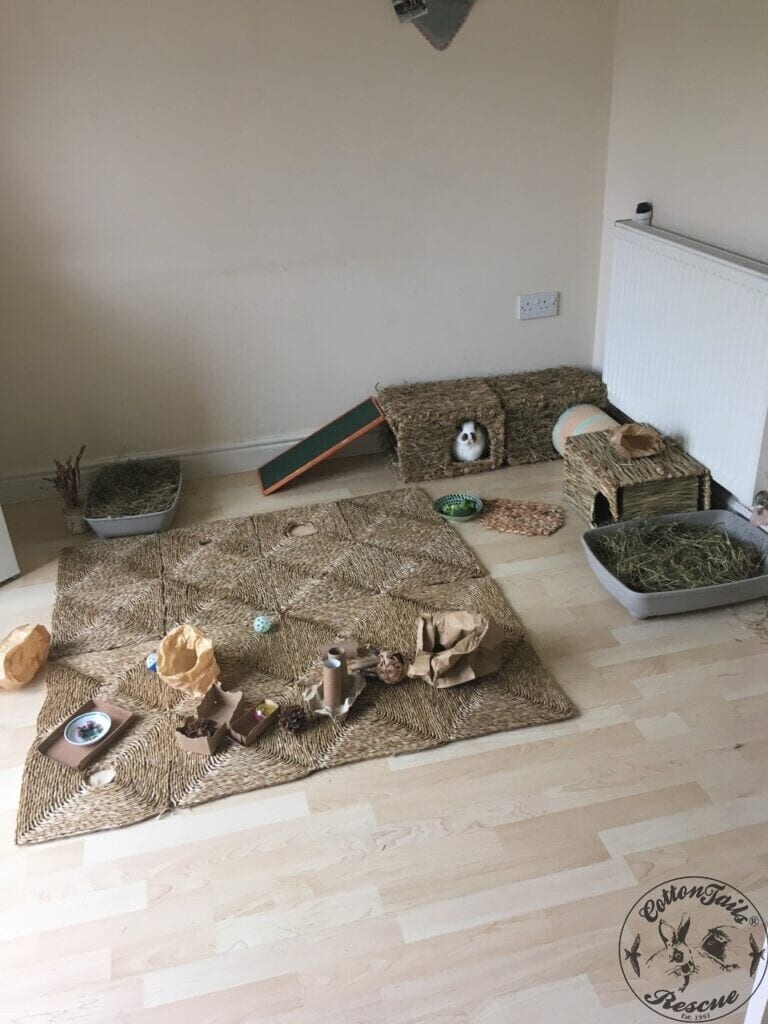
If you would like more information on this topic, do have a read of the bonding article elsewhere on the website.
Matching an existing rabbit with a new companion is generally a routine procedure, but seek advice and help from someone experienced in rabbit match-ups, or have a read of the bonding article elsewhere on the website as the procedure can go wrong unless specific issues are addressed from the start.
Guinea pigs are not good companions for rabbits, and this combination should be avoided. Our match-up article on this website contains essential information about finding a friend for single rabbits and is thoroughly recommended reading. The photo below illustrates the dominant rabbit of a bonded pair demanding grooming from his partner by putting his head under her chin. It used to be thought that this was a gesture made by the submissive partner, but it has been found that the dominant rabbit exhibits this behaviour.
Although rabbits will occasionally co-exist in groups if they are all neutered, in most cases, severe fighting will start at some point later on, even if they start very amicably. A typical example of this is where a litter is kept together on the assumption that they will stay bonded for life – sadly, this is rarely the case, and the litter mates should all be neutered and then placed into opposite-sex pairs if possible. For more information on this topic, do have a read of the bonding article elsewhere on the website. The short film below shows how easy it is for owners to get a false sense of security about the likelihood of a litter staying friends in the long term – who could not fall for the charms of these four little bundles!
.
Rabbits and Other Pets
Remember that if you already have another pet, such as a cat or dog, they may not be as welcoming to the new family member as you are! Be careful and sensible, and do not allow unsupervised contact, especially if the rabbits are babies. It only takes seconds for a cat to pounce and kill a baby rabbit, and likewise, a dog to kill even a large adult rabbit, so be aware of the situation and do not take it for granted that your pet will respect this new intruder! Most dogs can be trained not to worry a rabbit, but certain breeds will find it almost impossible, so think it through before taking on a rabbit as it may end in disaster.
Likewise, most cats can be trained to leave rabbits alone, and adult rabbits usually chase cats away, causing the reverse problem! As the photo below shows, various species of pets can live in harmony together, but do not expect too much too quickly and be prepared for instinct to kick in under certain circumstances.
 What Breed to Choose
What Breed to Choose
While you may prefer a particular type of rabbit, such as a lop, an upright-eared bunny, a giant, or a miniature breed, the most important thing to consider is the personality of the individual concerned. The novelty will undoubtedly wear off quickly if your beautiful pedigree top-of-the-range rabbit turns out to be the monster from hell! You will not know the personality for real until the rabbit is about five months old, as rabbits change dramatically at around this age.
The most critical issue is space if you consider taking on a giant breed (as in the photo above). Have you got the room to accommodate such a rabbit? Not only that, they can be even more destructive than an ordinary rabbit and, of course, will eat more and produce more droppings and urine, so it can be much more work. Also, as they are almost impossible to handle due to their size, it can be challenging to administer medication if you ever have an illness problem with them! As much as they are fantastic rabbits, do think long and hard before taking such creatures on. They live a shorter life than average-sized rabbits, rarely getting beyond five years of age. Miniature breeds are not without problems; many are prone to dental disease and/or temperament issues, so it is vital to choose with care.
For information about the Rex breed, scroll down to the end or click on the “Rex” heading on the right-hand side of this page.
Grooming
Thinking long and hard before taking on a long-haired rabbit would be best. Much work is involved, and information about grooming long-haired rabbits is available in this website’s “Grooming” article. Short-haired rabbits do not need grooming so long as they are not allowed to get overweight or have some disability. If they are having a very heavy moult, a double-bladed cat comb is helpful to remove the dead fur in their coats, and this is an important task to do as although consuming fur is not thought to be the leading cause of gut stasis (covered separately), it certainly may be a trigger in a rabbit prone to this often fatal condition.
Toys
It is imperative to give rabbits items they can chew, dig at and destroy if they want to, and even a cardboard box works well. Many toys are available from pet stores, and some will appeal more than others, but you often find the most interesting playthings are articles you have around the house, such as wicker baskets. Do NOT be tempted to use cat balls, as seen in the photo below (the ones with a little jingle bell inside), as they are very dangerous for rabbits as they can get their front teeth stuck in them, causing panic and distress.

As shown below, rabbits enjoy toys such as forage boxes that make them work things out. Photos taken by owner Jasmine Thayer, and she said:
The rabbits have been having ‘paper twists’ filled with a few Excel nuggets, so they have to try and unravel the paper. Oreo made short work of this!! And Minky Binky was learning from Honey how to get the pellets out of their “giant tissue box”, as I’d only given them a tiny gap in the top to get the hay and treats inside!
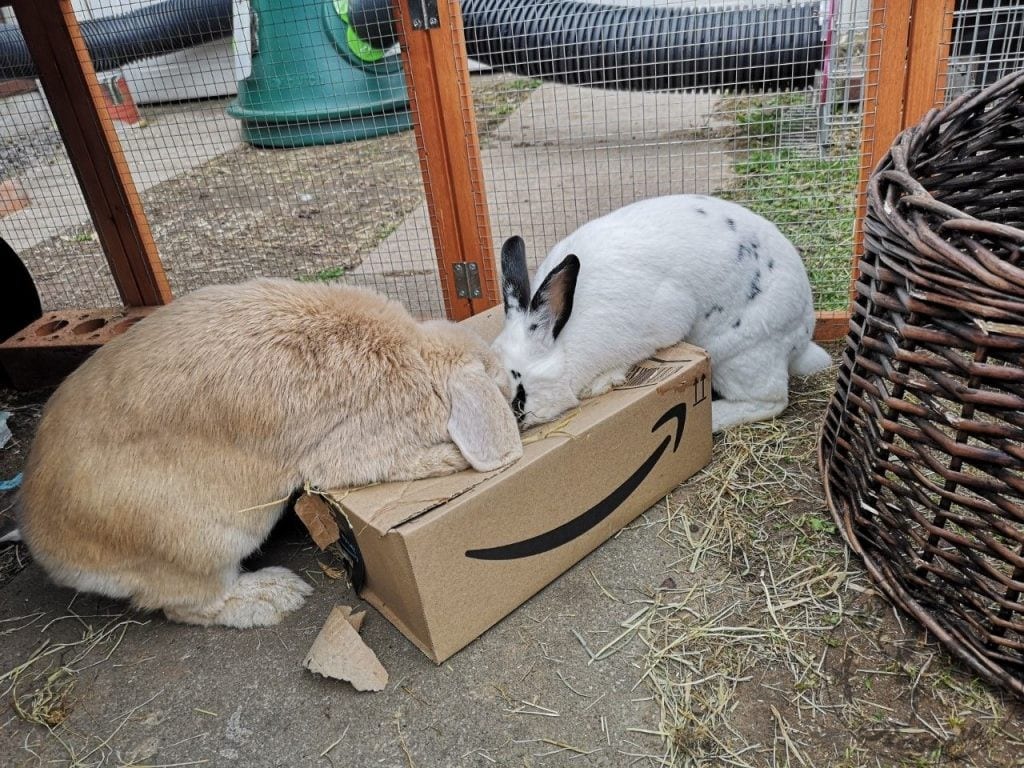
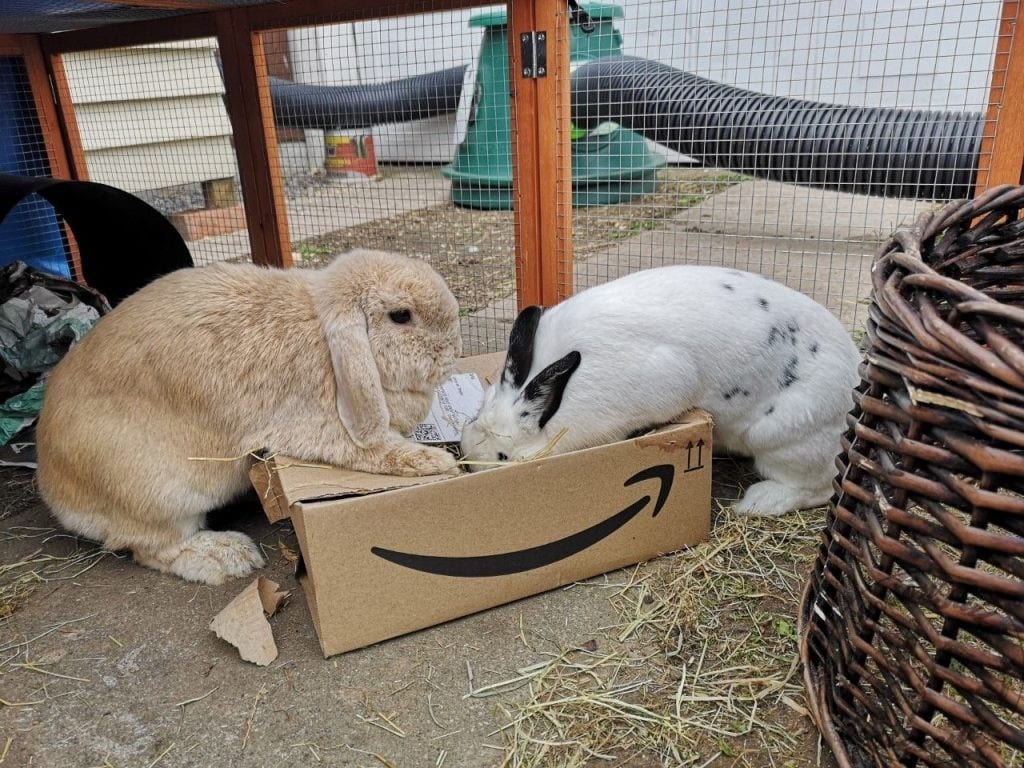
Ryan and his family devised this clever idea to keep their bunnies happy!
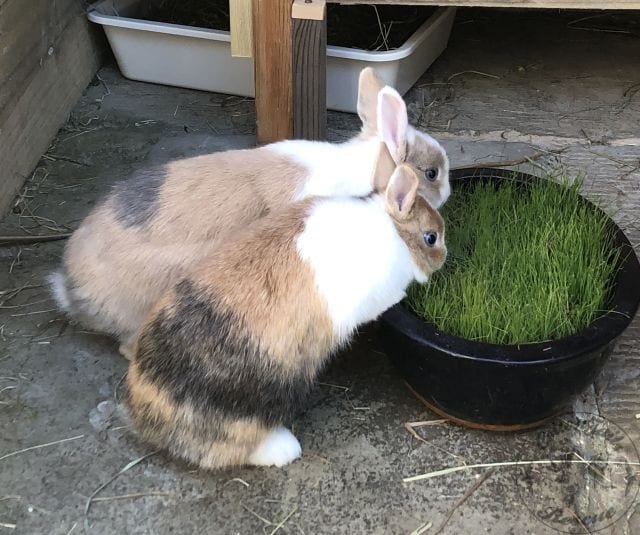
Housing and Accommodation
For anyone who still thinks it is okay to shut a rabbit into a hutch, have a look at the film clips and photos below, and you will surely change your mind …
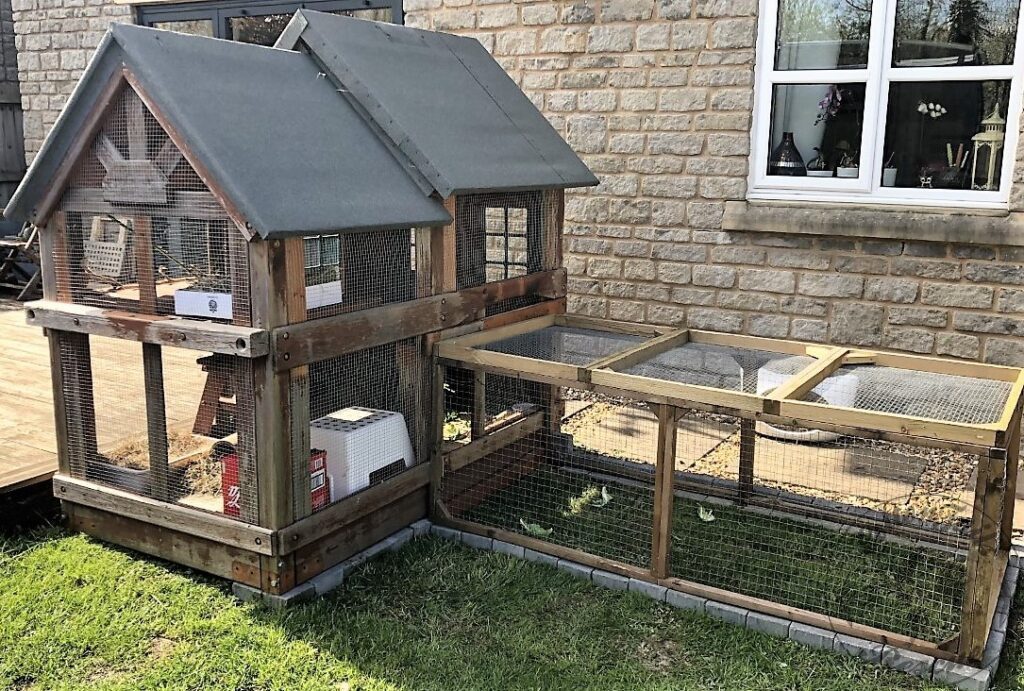
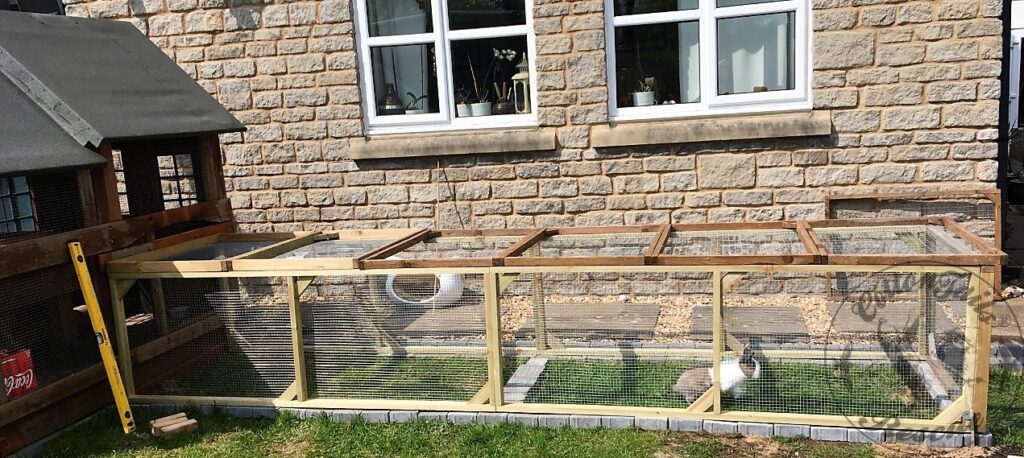
Rabbits can be housed outside all year round in a good quality weatherproof hutch with a separate draught-free dark area, attached permanently to a secure run, as illustrated above. Do not be concerned if your rabbit uses the sleeping area as his toilet, as this behaviour is expected. A litter tray can be used in the hutch in the corner where bunny usually chooses as his potty corner. The hutch must be at least 6” off the ground and should be sited out of direct sunlight and draughts.
Please ensure that padlocks or bolts are used for fastenings on both hutch and run to prevent foxes from accessing them. Wire mesh used on hutches and runs should be strong (not chicken wire). The whole structure should be situated on the patio to prevent burrowing out by the rabbits or burrowing in by foxes. Cover the hutch felting with white roofing plastic or paint it white, as there is no doubt that a white roof keeps the inside of the hutch cooler in hot weather.
If you have a plastic lid on the run, you can coat the inside with greenhouse shading if there is a danger of the rabbits overheating. Be very careful if you are considering purchasing a hutch on two levels with a ramp in between. It has sadly been shown that rabbits can incur serious injury by getting a hind leg trapped under the ramp where it joins the upper level, with fatal results. Many rabbits cannot negotiate the ramp safely, so I suggest you go for a large hutch on one level with a run attached unless you purchase a very small rabbit.
If you have already bought a hutch with a ramp and cannot return it for something more suitable, the ramp can be replaced by a set of “pet steps”, which can be bought online or from large pet shops. Rabbits find steps far more accessible to negotiate and much safer than ramps. You would also need to add a run to the front, as the double-level area is not big enough for rabbits. The photo below the film clip underneath shows an adapted double-level hutch with an added run fitted onto the front. Out of view is a set of pet steps allowing rabbits to get to the upper level safely.
If you are unable to either get hold of pet steps or the size of the accommodation does not allow them to be fitted, you could adapt the ramp by either attaching plywood “sides” to the ramp to make it safer, or you could construct a “tube” to fit around the ramp forming a tunnel, which rabbits love to go through. The tube can be made from lino for guinea pigs, but this will likely not work with rabbits as they may consume it with unhealthy results, so cardboard could be used and replaced as and when required.
The photo below shows a ramp adapted for guinea pigs using lino. The rabbit version would need to be bigger to allow them to go through safely. Also, remember that even this idea will not protect a rabbit from injuring itself on a tight turn at the top or avoid leg injuries in the gap at the top, so it is best to avoid double-level hutches altogether if possible.
Below is a short film that puts across the topic of rabbit accommodation in a fun way:
Some owners use a shed or Wendy House as their rabbit’s accommodation, as shown below.

If you are worried that your rabbits’ hutch is not as warm as it should be during a cold winter, you can insulate it by buying bubble wrap from a garden centre and fixing that on the sides and back on the outside, covering it with tarpaulin or plastic sheeting to protect it – you will need to protect this covering to prevent the rabbit from eating it if it has access to the outside of the hutch/house. This insulation can be removed in the spring if required. Do not be tempted to completely cover the front, as air must be allowed to flow in.
If you have to cover the front (remember that they are rabbits and are generally very hardy!), cover no more than three-quarters of the wire door. Below is a photo of an alternative type of accommodation, in this case, housing two pairs of rabbits, each pair occupying half each but still having lots of room to run around and keep active.
Some people decide to bring their rabbits inside for the winter and divide off a part of a room (or devote a whole room) for them to live in, but as rabbits are very hardy, you don’t have to if you don’t want to. The photo below shows another way of giving rabbits an excellent environment. An electric fence to keep out foxes is fitted all around the perimeter to keep them safe.
The photo below shows the opposite end of the previous photo. It shows the electrified perimeter fence on the left, which allows the owners to keep free-range rabbits, chickens, and ornamental wildfowl. A section of 6-foot board fencing protects this end.
The photo below gives another example of a hutch/run situation, this time inside a shed for the winter (with the top removed for the photo)
The photos below show other good alternatives:
Visible in the photo below is the underwiring you must do if the rabbits live on the grass to stop them from digging out and foxes from digging in.
Quite a few rabbit owners are now using the run-around system, where areas are connected via tubing or wire tunnels. This enables the rabbits to move from area to area safely without necessarily running loose in the garden.
Some people use greenhouses and conservatories, but these are often only suitable in the colder months as such accommodation can heat up quickly with fatal results in warm weather. The photo below, taken by owner Jasmine Thayer, shows a pair of bunnies in their temporary accommodation before the weather started to warm up.
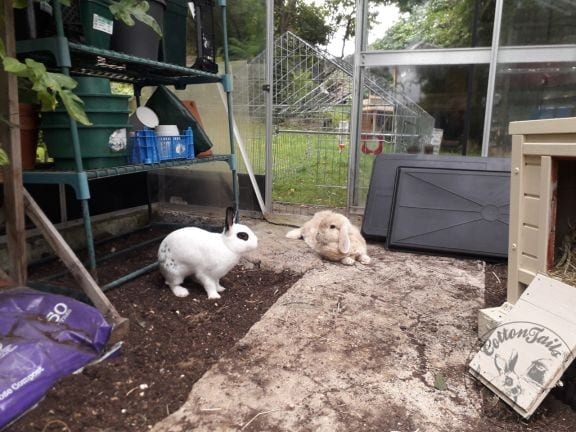
Below is a film by foster carer Nicki showing how her current foster bunnies are using this system, although, on the day of filming, they were also allowed free access to the garden.
Digging
It is essential to know that rabbits can dig and dig quickly and efficiently. A determined rabbit can dig out of a run on the lawn within around 30 minutes, possibly less if she gets help from a friend! Females are more likely to burrow than males, but some males will still dig, so this must be considered if you intend to put your rabbits out on the grass. If your rabbit is a proficient digger, you must line the run with chicken wire to prevent an escape. The photos below show what was achieved within 30 minutes of this rabbit being placed in a run.
Considering that most rabbits instinctively want to dig, giving them a dirt or sandbox is a good idea so they can enjoy this activity without causing damage to their accommodation or harm to themselves by escaping. You will see below two photos (supplied by the rabbits’ owner Jasmine Thayer, the rabbits were originally adopted from us) to illustrate this. Some owners use soil, some use sand (don’t use the builder’s sand as this can contain a dye that may affect the rabbits and will stain their fur), and some use bark chippings, so there are various options.
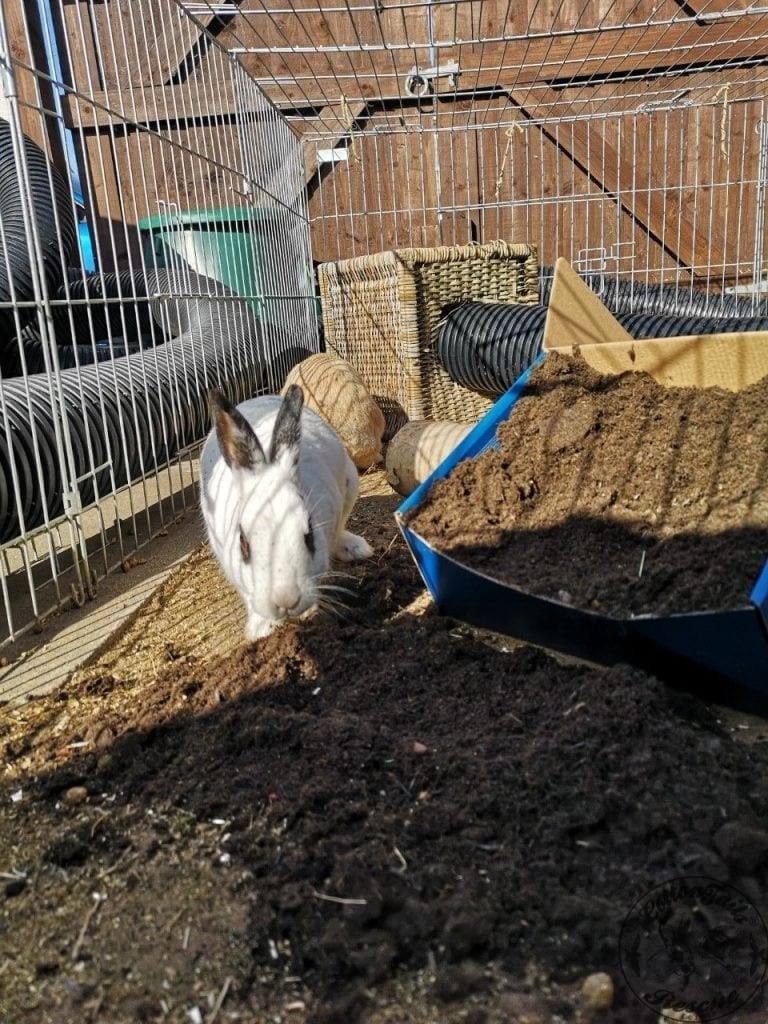
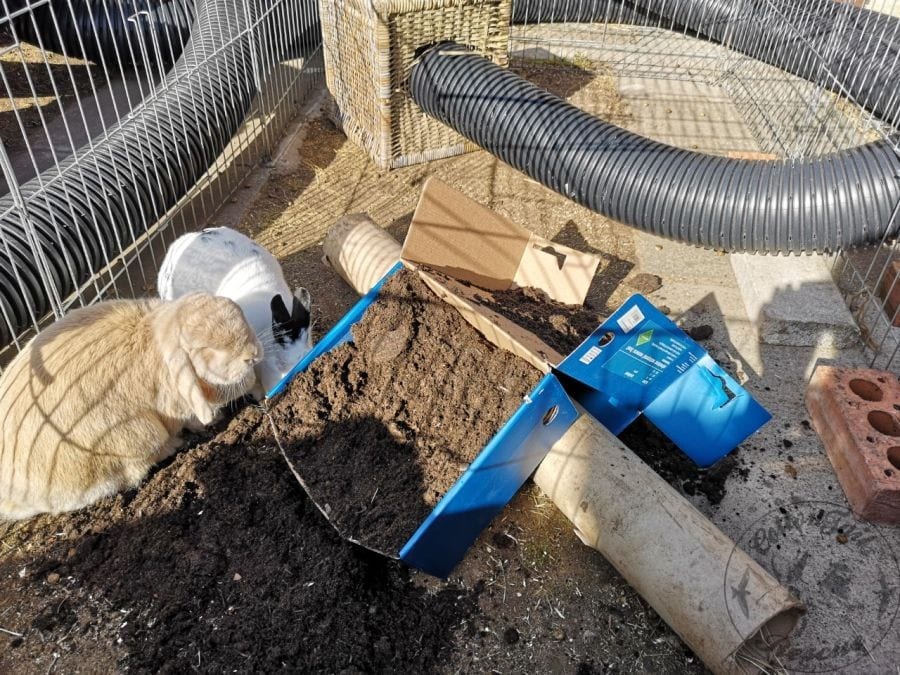
For the winter months, you will likely need to add cladding to the hutch and/or run to ensure the rabbit stays draft-free and warm. There is a type of plastic sheeting that is easy to fit and cut to size (even scissors will do), and I have included photos of this sheeting below (other brands will likely be available). I have also included two photos of our main bunny section with the plastic sheeting fitted to the runs and hutches.
The washing-up basins on the run tops were in place due to a storm with high winds being forecast, and the basins are an easy way to ensure the tops do not bump and bang or the catches to be torn from their anchors and allow the lid to lift off. The basins provide a convenient way to combat such situations; not only can they be stacked inside each other for easy storage, but they also only take seconds to fill each one with water to act as ballast.
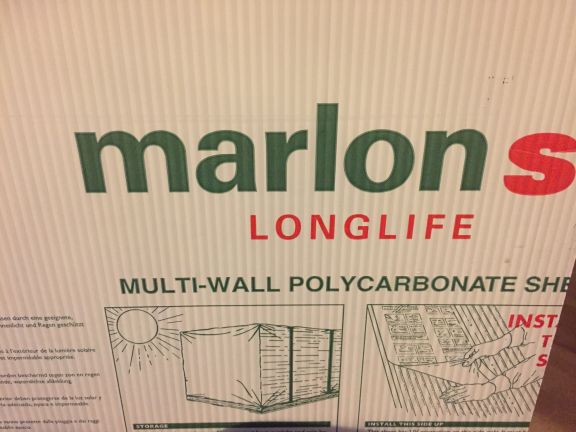
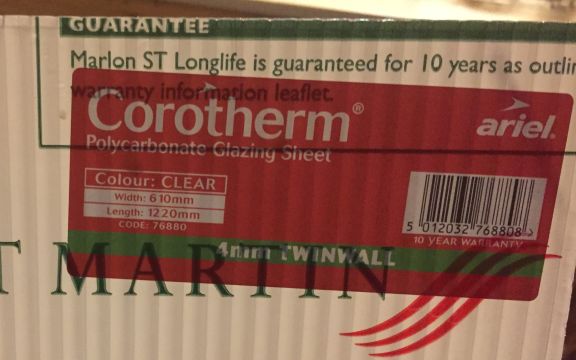

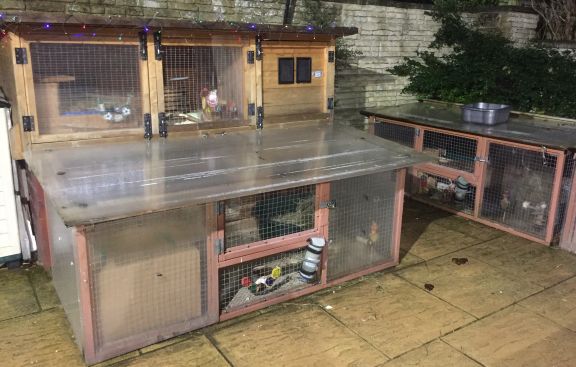
House Rabbits
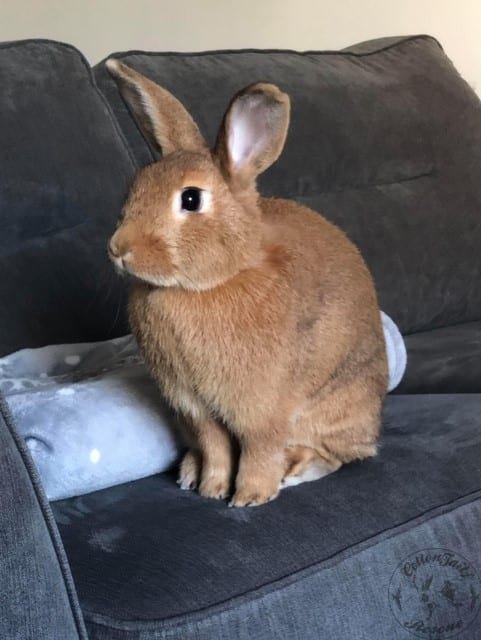
So, are you seriously considering taking on a house rabbit or two? Read on! The first thing to know is that keeping a rabbit as a house pet does not mean keeping it in a cage – no rabbit should be caged without the option to exercise, and house bunnies are no exception. Rabbits, by nature, are active at night and during the day, taking naps as and when it suits them, so it is not acceptable to shut a rabbit into a cage at night or when you are out. Suppose the issue is safety for either the rabbit or your furniture. In that case, you need to set up an enclosure so the rabbit can run around if it chooses to but cannot access other parts of the house or precious possessions or annoy other house inmates. If you think this is not feasible, a house bunny is not the best choice for you, and you either need to consider keeping a bonded pair outside in a safe enclosure or maybe even choose a different pet that will suit your lifestyle and expectations better. For more information on house rabbits, with advice on how to make a success of it, have a read of the House Rabbit article on the website.
Bedding
The photo above illustrates why newspapers are not very suitable for bedding! Instead, use a deep layer of dust-extracted wood shavings throughout the hutch, with a good layer of hay. Litter trays can be filled either with a covering of shavings and hay or a wood-based cat litter. Remove all soiled bedding daily, spray the area with animal disinfectant and replace it with fresh bedding, thoroughly cleaning out the whole hutch once or twice a week. You may use newspapers underneath deep woodshavings or the bedding in litter trays, as long as the rabbit does not discover it!
Water Provision
The amount an individual rabbit will drink daily depends on various factors such as weather conditions, temperature, diet, social grouping, accommodation, activity levels, and general health and hormonal status. The critical thing to notice with a rabbit is any changes, and as far as water consumption is concerned, this means being aware of any sudden increase or decrease in the amount of water drunk. Make sure that the rabbit is provided with an efficient and fully working water source.
If using a water bowl, bear in mind that if the rabbit turns the bowl over, fills it with bedding whilst digging, or fouls the water with urine or droppings, the water source is then absolutely useless, and the rabbit could become dehydrated very quickly, especially on a hot day. Water bottles are better from this point of view, but you need to ensure they are working correctly and don’t freeze in cold weather (the spout is the first part to freeze).
I carried out a study on rabbit water consumption in October one year during a reasonably mild spell with temperatures during the day about 12°C. Twenty-one rabbits were monitored over six days, and the amount they drank daily was carefully measured, and an average figure was calculated. All the rabbits were fed the same type and amount of food and were given fresh vegetables daily in addition to ad. lib. meadow hay. I found the average amount drunk per rabbit per day was 67mls, but this amount did vary considerably between individuals, with the minimum drunk being 10mls and the maximum 160mls.
The critical point to learn from this study is that water consumption will vary depending on the variables listed above, which is not abnormal. However, any sudden changes in consumption (up or down) should be noted, and possible causes should be investigated to prevent health issues from developing or catch existing conditions early enough to ensure successful treatment.
Feeding
Below are some short films about how to feed your rabbit:
The most common problem we see here at CottonTails is overweight rabbits. This topic of obesity and its serious consequences are covered in the problems article elsewhere on the website. Be consistent with the type of dry food given and stick to it. As a general guide, miniature breeds such as Netherland dwarfs should be fed half to one egg cup full once daily. Medium breeds up to about 3kg should be given one egg cup (flat, not heaped) each once daily, and giant breeds should be given an increased amount accordingly.
Handy measures can easily be obtained in supermarkets and are sold in packs of four brightly coloured measures. The smallest is ¼ cups (65mls), ideal for a single average-sized rabbit, and the middle-sized one is ½ cups (130mls), suitable for a pair of average-sized rabbits sharing a bowl. The rabbit will usually finish the food quickly and then graze on green vegetables and hay for the rest of the day.
Hay should comprise 70-80% of the total diet. Fruit should not be fed apart from an occasional treat, and carrots should be given sparingly. More details on vegetables follow later. Some domestic rabbits have a poor tolerance of vegetables, especially if under 16 weeks, so proceed with caution; otherwise, severe diarrhoea may occur with fatal results. Start by offering tiny amounts of various vegetables, such as celery, every other day and gradually build up the amounts over weeks. Stop immediately if the rabbit has a dirty bottom or runny droppings, often resolved by withdrawing the fresh food. Seek veterinary advice if this is a persistent problem. Also, see the section below about this issue. Never feed lettuce to a rabbit of any age.
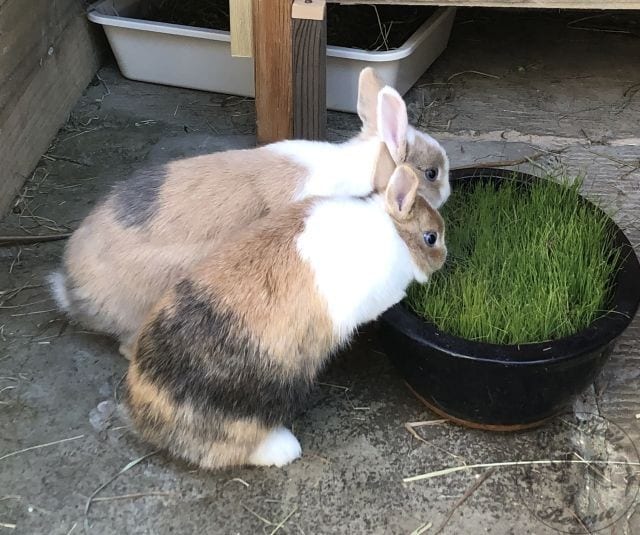
Rabbits should not be fed extras such as bread, toast, cake, sweets, biscuits, crisps etc. Treats, as shown in the photo above, can be given if the rabbit enjoys it, but they need to be in the form of food they would have been given anyway, such as little pieces of vegetables or some pieces taken out of their daily dried food quota. Refill the water bottle daily, and add large handfuls of fresh hay. Rabbits need to have large quantities of fibre in their diet daily to ensure that your rabbits have access to fresh hay every day of the year.
Grass is even better than hay (not mown clippings, however) as it is more abrasive, even though grass looks softer! Examples of fresh food you can give your rabbit are celery, cabbage, cucumber (small amounts), cauliflower leaves, spring greens, broccoli, carrot (very small quantities), brambles (blackberries), fruit and leaves, groundsel, mint, parsley, raspberry leaves. The following can be given in very small amounts as an occasional special treat: apples, dandelions, melons, peaches, pears, pineapple, strawberries, and bananas. The photo below shows the vegetables I feed a pair of rabbits daily.
Poisonous Plants – there is a very long list of plants that can be toxic to rabbits, and I have included the commonest ones (in the UK) here: all plants that grow from bulbs, amaryllis, arum lily (cuckoo point); bindweed (convolvulus); bracken; byrony; buttercup (small amounts dried in hay is ok); deadly nightshade (belladonna); delphinium (larkspur); elder; fool’s parsley; foxglove; hellebores (Christmas rose); hemlock; henbane; lily of the valley; lupin; laburnum; most evergreens; oak leaves; poppies; potato tops; privet; ragwort; rhubarb leaves; scarlet runner; toadflax; woody nightshade; yew.
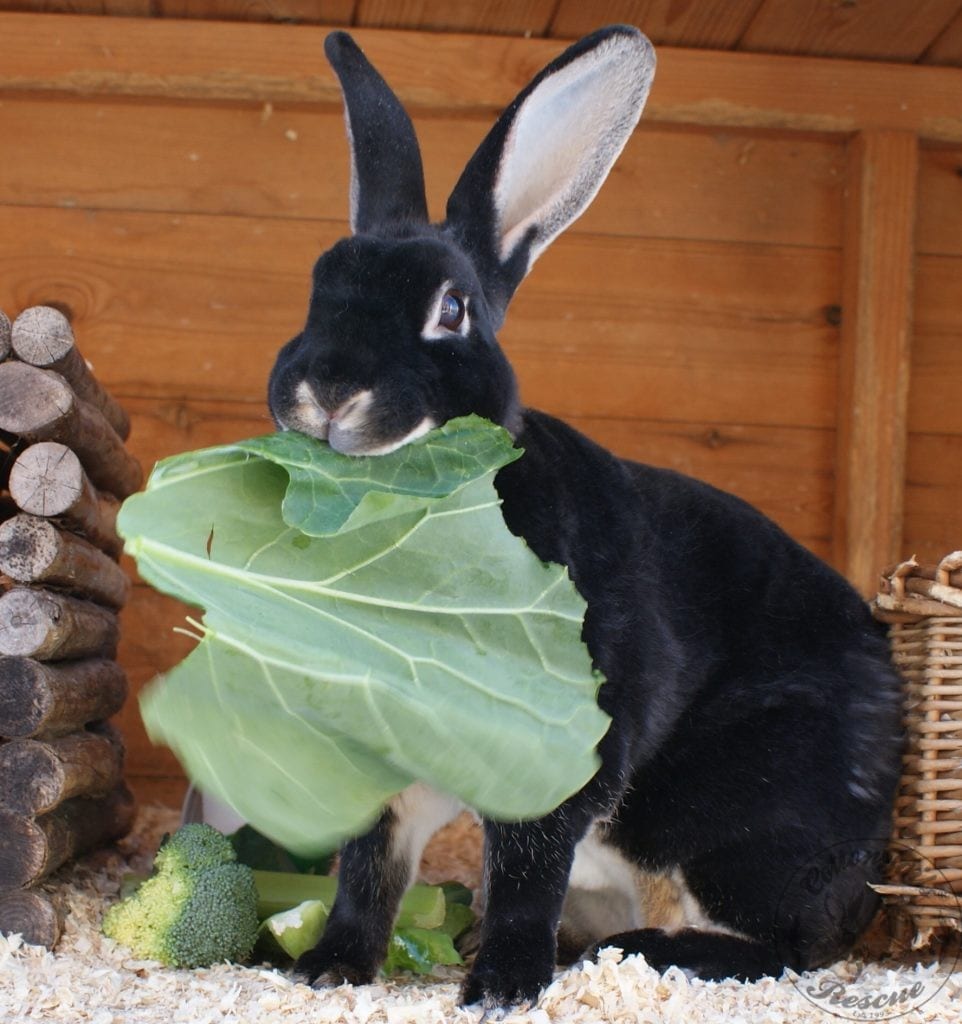
It is essential with any rabbit, especially young ones, to make changes very slowly. If you do not know what your rabbit has been given in the past regarding vegetables, it is best to start with something safe like celery. Offer about a quarter of a stick once a day for a few days, and if there are no soft droppings or tug-of-war, you can then introduce a piece of spring greens for another few days. Assuming that all is well, you can add a small piece of broccoli until after a couple of weeks; the rabbit has a selection of green vegetables daily.
With young rabbits, you must avoid fruit entirely and only give a very small slice of carrot per rabbit as it is high in sugar and often gives soft droppings. Most rabbits benefit from having green vegetables daily, but some individuals cannot tolerate this; therefore, it is always best to proceed slowly. Sometimes, feeding time can trigger irritability between bonded pairs of rabbits, as is shown in the film below, where a game of tug-of-war took place!
Breeding
If you find yourself in the unfortunate position of having an unplanned litter of baby rabbits due to the wrong sexing of the parents or other similar situations, you will find lots of relevant information in the hand-rearing section, as it not only tackles the hand-rearing of orphans but also covers what to expect as far as mum’s behaviour is concerned and also has valuable hints about what to expect with the babies. In most cases, Mum manages the whole thing herself, and it is normal for her to ignore them all day as they are only fed once a day, usually at night. Part the fur once daily to ensure the babies are together in one group and look fat and content. This can be done when mum is out of the hutch in her run, and if you leave her out for at least an hour afterwards, she won’t even know you have had a peek.
If you have more than one rabbit living in the area where the babies are, see the article Rabbit groups – females with litters on the website for information on what you need to be aware of. If you have a double-level hutch, do be aware that the chances of some of the babies accidentally ending up dead at the bottom of the ramp is high, so you either need to move the whole nest to the safer lower level or shut mum in the top level with the babies at night to prevent such accidents happening. Double-level hutches are not at all suitable for breeding rabbits!
Thousands of unwanted rabbits are taken in by rescue centres every year, mostly children’s pets that have been discarded once the novelty has worn off. This being the case, it is irresponsible to generate yet more rabbits by indiscriminate breeding. You cannot assume that your local pet shop will take any excess stock, nor can you rely on selling them via the local paper.
Furthermore, dental disease is primarily an inherited condition. Some babies will likely develop tooth problems later in life if you use rabbits with unknown history. Contrary to popular belief, breeding will not cure a female rabbit of aggressive behaviour in the long term, and this is usually only resolved by neutering and providing a stimulating environment with lots of room to run around.
There is very little profit (if any) in breeding rabbits if they are to be appropriately kept with a good quality of life, as the equipment, vaccinations, and preventive treatment for E. cuniculi are all very expensive, so professional advice should be sought beforehand to establish if the project is going to be feasible both from the welfare and the financial point of view. It is irresponsible to decide to breed from your pet rabbit!
Neutering
Rabbits of both sexes should be neutered. Aside from preventing breeding, castration stops males from spraying urine and decreases mounting behaviour, whilst spaying females prevents the development of uterine and associated cancers, which are very common in female rabbits, and reduces aggression linked to hormones. The operation must be carried out by a confident and experienced vet who has performed such procedures on rabbits. The adhesive is now used to seal the incision instead of the old-fashioned method using external stitches, frequently chewed by the rabbit with often fatal results.
Rabbits can be safely neutered at an early age, which avoids the problems of fighting, breeding and issues with pair bonding. Males can be castrated as soon as their testicles descend, usually at around 10-12 weeks. Females can be safely spayed from 14-16 weeks, so long as they are in good health and weigh at least 1 kg.
Please take a look at a separate article about neutering for more information, especially if your rabbit is female. It is rare, but sometimes, a female will make a nest of pulled fur shortly after spaying. This is nothing to worry about so long as she does not interfere with her operation incision, so just check that all is well.
Vaccinations
A three-in-one vaccine is now available, so your rabbit only needs to visit the vet once a year for its annual vaccination. It can be given from around six weeks, with a booster yearly. This vaccine protects rabbits against Myxomatosis, RVHD1 and RVHD2. Although extensively tested before this vaccine is made readily available, there will always be cases where some rabbits react to the vaccination more significantly than others. Here at CottonTails, a very small number of rabbits reacted to the original combined vaccination when the most recent version first came out but have had no reactions since.
Vaccinating your rabbit could save its life, so this should be part of your commitment to keeping your pet healthy and happy. House rabbits should also be vaccinated, as all three diseases can be spread by biting insects that can easily come into the house. Other infection transmission methods also occur, such as contact with other rabbits or carrying the disease on your clothes, shoes, and hands.
The reaction to the combined vaccine included eye symptoms that developed approximately eight days after the injection and skin irritation around the injection site appearing after around 12 days. At no point were any of the rabbits ill, and they had good appetites and appeared to behave normally throughout. The symptoms disappeared within a few days with no long-term effects.
Vaccinating your rabbits is important, as the chances of them catching and dying from any of the three fatal diseases are far higher than possibly having mild side effects from the injection. As the latest vaccinations appear to have little or no side effects, there is no excuse not to protect your rabbits. The photo below shows one of the rabbits that had a mild reaction to the vaccination when it was first released several years ago, and I have included it here just in case it may help an owner should they have a pet rabbit show such symptoms.
It is rare, but some rabbits can develop mild myxomatosis despite vaccination. Still, they can recover if given appropriate supportive care such as antibiotics (to prevent any secondary infection), pain relief, and fluids as required. They don’t usually lose their appetites but can develop respiratory issues, which can lead to complications. The photos below show a rabbit that developed the nodular form of myxomatosis (as demonstrated by the sores around the nose and mouth, and also the inflamed corner of the eye) despite being vaccinated, but likely was infected before the vaccination was properly effective (it can take three weeks before the rabbit is fully protected).
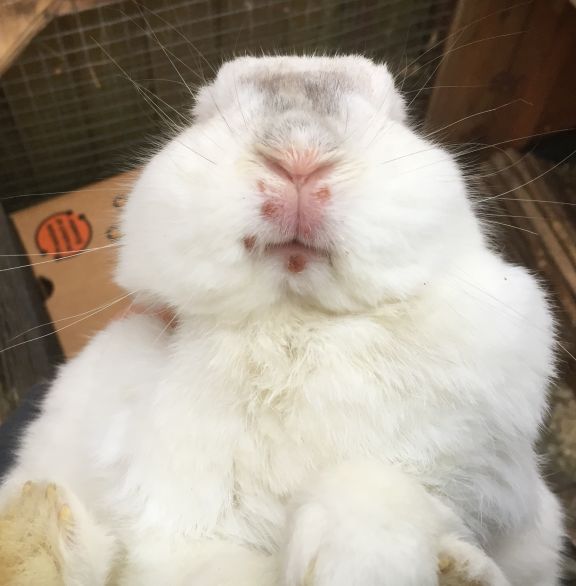

Viral Haemorrhagic Disease (VHD/RHD) Versions 1 and 2: Viral Haemorrhagic Disease, also called Rabbit Haemorrhagic Disease, versions 1 and 2, is a highly contagious condition, easily spread, and there are often no symptoms to indicate that anything is wrong. This disease is inevitably fatal and usually kills all rabbits in the vicinity. The photo below shows a common reaction to the old type of single vaccination against VHD alone, which has now been phased out.
Myxomatosis: Your rabbit is more at risk from this disease if you live in a rural or semi-rural area, but cases have been observed in pet rabbits living in inner city areas and in house rabbits. The disease is usually spread by biting insects such as fleas and mosquitoes. E. cuniculi See also the section below. Rabbits should be treated with Panacur (Lapizole and other products available from your vet) to kill off any E. cuniculi (a common parasite) that may be present. This should be done at the same time as the vaccinations. It is a 9-day oral course that needs to be repeated if the rabbit mixes with others at any stage or goes into boarding accommodation. If the rabbit has been diagnosed with E. cuniculi, the treatment would last 3-4 weeks. For more information about E. cuniculi, read the article about gut stasis on the website.
Aggressive Rabbits
I have covered this subject in detail elsewhere on the website (see Aggressive Rabbits article), so I will only repeat some information here. I will still briefly discuss a seasonal problem some owners may have encountered. It is common to find that a normally manageable female suddenly becomes grumpy and aggressive during January and early February. This is a result of the lengthening daylight, which is a trigger in wild rabbits to mark the start of the breeding season.
Even spayed females can react this way, as the pineal gland in the brain reacts to the increase in day length to stimulate a behaviour change independent of whether they are neutered. The good news is that this phase does not last very long, and usually, after a month or so, the rabbit will return to normal again. Neutering will help, however, as although it will not prevent the mood change from happening entirely, it will make it less extreme. Not all rabbits are affected, but enough of them are to justify the inclusion of this information here. Below is a short film tackling the issue of how to feed an aggressive rabbit.
Ears
I am stating the obvious, but a rabbit’s ears play a very important part in their awareness of what is around them, and they are also a vital part of communication between one rabbit and another. Whilst this is true in rabbits with “natural” upright ears, lop rabbits deliberately bred with defective cartilage that allows the ears to drop can be disadvantaged when communicating effectively with others. Body language and pheromonal cues are also very important in rabbit-to-rabbit communication, so a lop rabbit will get by. Still, it can be an important consideration when bonding a rather difficult bunny!
Below is a film I made to try and find a new home for Ludo, a lovely neutered male lop crossbred that had been here for several weeks. While filming, I realised I could take the opportunity to explain a bit about how rabbits can use their ears to communicate how they are feeling. As Ludo is a lop crossbred, he had several choices with what position to put his ears in, whereas in a true lop, the ears will hardly move at all, and in an upright-eared rabbit, the ears will not drop but can move from bolt upright to flat back, with various positions in between.
Next time you watch your rabbit, pay attention to their ears – you may be surprised that you can work out what they are thinking. Do bear in mind that if your adult upright-eared rabbit suddenly has a dropped ear, there could be a problem, such as ear mites or infection, and this needs to be checked just in case. Some lop crossbreeds will alter their ear positions as they get older, and this is normal and nothing to worry about, but if in doubt, get your rabbit seen by a vet.
Probiotics and Prebiotics
Many rabbit owners will be aware of the term probiotic as vets often recommend it when a rabbit has a digestive upset. But what is it, and what is the difference between probiotics, prebiotics and synbiotics? Probiotics are an organism, usually bacteria but sometimes a yeast, which can be given in food, water or as a paste to animals, including humans. Such bacteria and yeast already colonise the healthy bowels of animals. Still, when a digestive upset occurs, this disturbs the natural balance of such organisms, resulting in chronic pain, poor absorption and diarrhoea.
Low-grade infections with bacteria such as E. coli, salmonella, or other gut-dwelling bacterial species can cause abnormal gut flora. Probiotics can produce chemicals that inhibit the harmful bacteria and stabilise the gut pH to make it more hospitable for the growth of normal gut flora or outcompete the harmful bacteria. There is also evidence that probiotics can increase resistance to gut diseases, possibly by stimulating gut wall immunity.
However, probiotics are species-specific, and an organism that works well in one species of animal may not survive the stomach of another, rendering it useless. The bacteria must be able to survive the stomach acids, the alkaline small intestine, and the bile acids. If you want probiotics for a rabbit, use one specifically for rabbits or small animals, not for a dog or cat!
Prebiotics are often packaged together with probiotics as they work together. Prebiotics are natural plant extracts that function as soluble fibre, assisting the function of the gut by slowing it down and providing something for it to work on. Soluble fibre helps to thicken gut contents and improve mixing and general gut movement, encouraging the growth and survival of probiotics which usually accompany it. Prebiotics are sometimes thought of as helping the probiotic bacteria to survive and function. Synbiotics are products that typically contain both pre- and pro-biotics acting together to assist each other (synergistically) and thus producing a better effect than either on its own.
Does an average healthy rabbit need any probiotics or prebiotics? Giving probiotics to healthy rabbits will not achieve any noticeable effects. Still, there is evidence that there may be a certain amount of protection against gut upset due to stress or illness if probiotics/prebiotics are given regularly. If your rabbit does suffer from frequent bouts of loose droppings, is prone to gut stasis, or you are aware a stressful event will be happening soon (such as moving house or introducing another rabbit), it may well be beneficial to give a combined probiotic/prebiotic preparation daily, mixed with food or water at the appropriate dose. Products such as Protexin Bio Lapis or Protexin Fibreplex may be helpful in such situations.
Digging Out Their Litter Trays
In most cases, once a rabbit is neutered, it will change its toileting habits and become relatively clean, happily using a litter tray or corner of the hutch or run to pass urine and droppings whilst munching on hay. However, some individuals never achieve this, and if this has always been the case, then it is unlikely to change, although different types of trays can be tried. This section is more about rabbits who have suddenly started to dig out their litter trays or hutch so that the soiled bedding is all over the floor or run, having been clean and tidy beforehand. There are several possible reasons for this:
It is common for elderly rabbits to have arthritis-related issues. This causes them mobility problems because they are not keen to jump in and out of higher-sided trays and often are not so good at raising their tails as high during urination. This can account for any new habit of urinating out of their trays, as they probably don’t feel it is worth the extra effort to get to a tray. In contrast, droppings can be a lengthy affair as they like to sit comfortably, nibbling on hay while occupied in this activity. If this is suspected, it may be worth changing the litter trays to lower-sided ones, such as dog beds, as this makes it easy to get in and out. They still have the high back and sides, but the fronts are lower. Suppose you find that the hind legs appear stiff when the rabbits move around. In that case, it is a good idea to try some Metacam (low dose, once a day), which you need to speak to your vet about, and this is often enough to take away arthritic pain so the movement improves.
If mobility issues are not the problem, they may be down to behavioural traits. One reason that could drive this behaviour is boredom. Rabbits need to be given mental stimulation and have their physical needs met. Sometimes, this can be resolved by bonding with another suitable rabbit (see bonding article) and/or providing objects with which the rabbit can interact, such as cardboard boxes, wicker or straw baskets, and other toys that can be chewed, played with, and ultimately destroyed! Branches from trees such as apple, hazel, and willow are also great boredom busters.
Persistent offenders can be determined to empty their litter trays no matter what, so sometimes, buying hooded litter trays with high fronts can deter a rabbit, as it is much harder to empty the contents if they have to be shovelled over a high edge. Furthermore, a large digging box partially filled with play sand, soil or bark chippings could be tried so they can officially dig without being a menace.
Some rabbits get too hot in the summer months and shovel out all the bedding from the hutch into the run so they can lie on the bare wood. If this is the case, you could consider supplying the rabbit with a large tile, available from DIY stores, as this provides a cool surface to lie on. Rabbits are rabbits and behave as such, and sometimes, it is just a case of trying to get the rabbit to modify their behaviour, if possible, by considering the ideas above. Still, some individuals are strong-minded, messy and easily bored, and you may just have to accept that you will be sweeping up every day!
Night Time Safety
If you allow your rabbits to roam free in your garden during the day, you will probably want them to be somewhere secure during the night in case a fox takes them, but bear in mind that pet rabbits are often very active at night, so don’t expect them to be happy to be shut into a cage! You are best to provide a secure hutch with a run attached even for nighttime accommodation (must be safe, of course). The process of actually getting them to go where you want them to go can be tricky! It is a good idea to feed the rabbits their dry food only at night once they are back in their night area, thus rewarding them. It can take a week or so for them to link their actions and the arrival of dinner.
If you are already doing this, think of giving them their fresh greens at night as a reward instead. A lot will depend on whether the reward system gives them the incentive to behave themselves or not. You will also want to provide some clear signal that you want them to come in – like using a whistle, clapping your hands, calling in a specific way, etc. As stated previously, there must be a run (or similar) attached to the night area, as if they are shut in overnight, that would be reason enough for them not to want to comply. So long as the area is safe from foxes burrowing in or rabbits burrowing out, rabbits appreciate the ability to be active at night.
Going Away On Holiday?
Remember to arrange for someone reliable to look after your rabbits whilst you are away. It is less stressful if you can find someone to come into your home so that the rabbits do not need to be moved, but if this is not possible, make sure you visit the boarding facility before booking. You should take their usual food with you so that the diet is not changed suddenly, and give strict instructions about feeding greens to ensure an upset stomach doesn’t occur. The run should be attached to the hutch to ensure the rabbits get exercise. If you are in Bristol, Bath, Wiltshire or the surrounding area, CottonTails provides excellent boarding facilities and has the advantage of many years of experience, including veterinary knowledge.
End of Life – Things To Consider
Most rabbits live their life to the full and have many years of fun and enjoyment, but even for the healthiest bunny, there comes a time when you will need to say goodbye. I read the following poem while waiting to see the vet to have one of my rabbits put to sleep, and the poem moved me very much. I would like to share it with you.
IF IT SHOULD BE
If it should be that I grow weak,
And pain should keep me from my sleep,
Then you must do what must be done,
For this last battle cannot be won.
You will be sad, I understand.
Don’t let your grief then stay your hand.
For this day, more than all the rest,
Your love for me must stand the test.
We’ve had so many happy years.
What is to come can hold no fears.
You’d not want me to suffer so;
The time has come — please let me go.
Take me where my need they’ll tend,
And please stay with me till the end.
Hold me firm and speak to me,
Until my eyes no longer see.
I know in time that you will see
The kindness that you did for me.
Although my tail its last has waved,
From pain and suffering, I’ve been saved.
Please do not grieve — it must be you
Who had this painful thing to do?
We’ve been so close, we two, these years;
Don’t let your heart hold back its tears.
— Anonymous —
The following is my response to a distressed owner whose rabbit had been battling dental disease for several years. Toby already had several abscesses removed, but they kept coming back, and it had got to the point that he was running away when she came near to give the medication:
“I think you have summed up the whole issue with one phrase: “he is becoming wary of me”. Let me briefly tell you about a dog that I had. Fala was 15 (a good age for a large dog), and although she still seemed reasonably happy, she had become incontinent, and I had to fit her with a nappy to avoid the obvious problem of her leaking everywhere. It got to the stage where she would run away every time I approached her, breaking my heart. After much thought and discussion, I made the difficult decision to let her go, and the vet came and put her to sleep. I am telling you this story because there is a bit of a similarity with your bunny, Toby.
Toby is reaching the end of his natural life and has battled bravely with a horrible incurable condition that, without a doubt, causes pain and distress when the symptoms are present. It has now got to the stage that his illness is affecting your relationship with him, and this is very sad. From what I can see, you have two choices – find a way of treating him to ease his suffering without him becoming distressed and afraid of you, or decide to let him go before his suffering makes his life unbearable. Only you can decide, which is probably one of the hardest decisions you will ever make. You must put your feelings to one side and consider what is best for Toby – the one thing we can do for a much-loved pet if they have a distressing condition for which there is no cure is to let them slip away in a pain-free and dignified manner in a loving and secure environment”.

